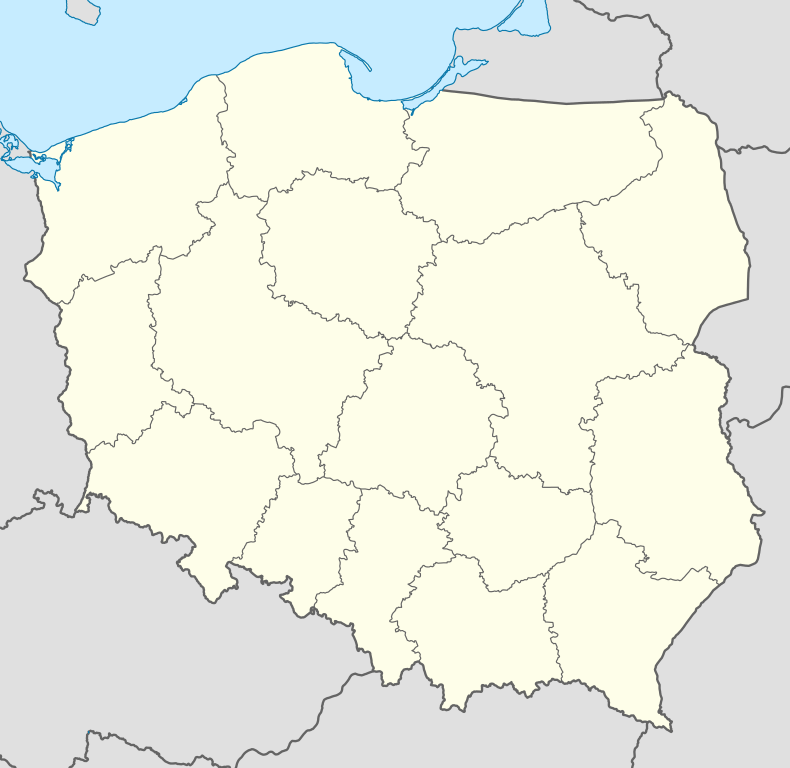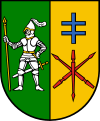Włodawa
Coordinates: 51°33′N 23°33′E / 51.550°N 23.550°E
| Włodawa | |||
|---|---|---|---|
|
Church | |||
| |||
 Włodawa | |||
| Coordinates: 51°33′N 23°33′E / 51.550°N 23.550°E | |||
| Country |
| ||
| Voivodeship | Lublin | ||
| County | Włodawa County | ||
| Gmina | Włodawa (urban gmina) | ||
| Government | |||
| • Mayor | Jerzy Wrzesień | ||
| Area | |||
| • Total | 17.97 km2 (6.94 sq mi) | ||
| Population (2006) | |||
| • Total | 13,630 | ||
| • Density | 760/km2 (2,000/sq mi) | ||
| Time zone | CET (UTC+1) | ||
| • Summer (DST) | CEST (UTC+2) | ||
| Postal code | 22-200 | ||
| Car plates | LWL | ||
| Website | Official website | ||
Włodawa [vwɔˈdava] (English variant: Wlodowa) is a town in eastern Poland on the Bug River, close to the borders with Belarus and Ukraine. It is the seat of Włodawa County, situated in the Lublin Voivodeship since 1999. As of 2011 it has a population of 14,800.
Geography
The town lies along the borders of Poland with both, westernmost Belarus and Ukraine, on the banks of the Bug River, 51 km from Chełm in Poland and Brest in Belarus; 64 km from Terespol, 86 km from Lublin, and 77 km from Liuboml in the Volyn Oblast of Ukraine. It is close to the Belarusian southernmost strip of the Brest Raion within the Brest Region bordering with north-western Ukraine.
History
Włodawa was first mentioned in historical records in 1242. The first written mention of the town in an Old Slavonic chronicle which speaks about Prince Daniel staying there, escaping from the Tartars in 1241. In 1446-1447 the surrounding territories were annexed into the Duchy of Lithuania and the river Włodawka marked the border between the Duchy and the Polish Crown. In 1475 Michał i Aleksander Sanguszko received the town in exchange with the Polish King Kasimir Jagiellończyk. For the next 100 years the town became the home for the Sanguszko family. They built their castle here and developed the town's prosperity. The Sanguszko profited from the border crossing which was bringing good income. In 1534 the town obtained city rights. At that time the influx of the Jewish population started, which promoted commerce and artisanship.
Jewish community

The existence of a Jewish community in Włodawa is first recorded in connection with the Lublin fair of 1531. By 1623 Włodawa had a representative in the Council of the Four Lands. The community's prosperity is due to the granting of a city charter in 1534. For much of the early modern period, a time when the Polish-speaking community of the regin was predominately engaged in agriculture, Jews appear to have composed much of the population of the city, engaged in all forms of craft production and trade. The community was devastated by the Chmielnicki massacres of 1648,[1] but afterwards re-established and rebuilt. By 1765 the town has 630 Jews. In 1693, the town had 197 dwellings, 89 owned by Jewish families. The census of 1773 records Jewish physicians, butchers, millers, barbers, goldsmiths, tailors, furriers, merchants, and carters, in addition to one Jew in each of the trades of coppersmith, cobbler, glazier, chandler, and wheelwright. There were also 8 schoolmasters, 2 educators, a cantor, a bass player and a cymbal player.[2] There were 2,236 Jews in 1827 and 6,706 in 1907.
In the late 19th century Włodawa had a Jewish-owned steam-powered flour mill, tannery and soap factory. Of the 184 stores in the town, 177 were owned by the Jews. Włodawa's first Zionist organization was formed in 1898, the town also had Bund, Agudath Israel and Poalei Zion organizations. There was a Beis Yaakov school for girls also.[3]
Włodawa was over 70% Jewish before World War II and the Holocaust. Situated next to the Sobibor extermination camp, Włodawa Jews were mostly rounded up and deported there, or killed locally in any one of the German arbeitslagers (workcamps) such as the one at Adampol. Several Jews from Adampol and the Wlodawa Ghetto were able to escape, and joined the Parczew partisans in the forests, fighting actively against the Nazi oppressors. The Jewish cemetery was demolished by the Germans who used the headstones as road building material. They used the synagogue buildings for military storage.
On the road to Włodawa there is a memorial to the Jews from Włodawa who were killed at Adampol. No Jews are known to live in the town today, although the handsome, Baroque, Wlodawa Synagogue serves as major tourist attraction. A Włodawa landsmenschafte (society) was founded in America for survivors and descendants of Włodawa's Jewish Community and has members scattered throughout the US, Canada, Australia, England, Israel and elsewhere. London had a Wlodawa Synagogue (London).
Attractions
There are several monuments and tourist attractions worth seeing in Włodawa:
- Saint Ludwik church and baroque monastery, founded by Pauline Monks in the 18th century.
- Czworobok, built in the 18th century in the shape of a rectangle. It was used by merchants to sell their goods.
- Wlodawa Synagogue of 1764, that is currently used to host exhibitions about Włodawa Jews as well as local folklore.
- Russian Orthodox church, erected in 1840-1843 and rebuilt in Russian Revival style in 1893[4] and is used by local Polish Autocephalous Orthodox Church community.[5]
- Włodawa State Museum (Polish: Muzeum Pojezierza Łęczyńsko-Włodawskiego), managing the Sobibór Museum neaby until April 2011
References
- ↑ Squaring of the Circle: Polish-Jewish Relations Through the Ages : the Story of an Unrequited Love, By Arnon Rubin, by Tel Aviv University Press, 2005, p. 10
- ↑ The complex of Synagogue Buildings in Wlodawa, Malgorzata Podlewska-Bem, Leczynsko-Wlodawskie Lakeland Museum, Wlodawa
- ↑ Encyclopedia of Jewish Life Before and During the Holocaust, Shmuel Spector, NYU Press, 2001, Vol 3, p. 1452
- ↑ G. J. Pelica: Ślady zapomnianego piękna. Włodawa i okolice. Włodawa: Parafia Narodzenia Przenajświętszej Bogarodzicy we Włodawie, 2009, p. 5-10. ISBN 83-85368-31-0.
- ↑ „Kalendarz prawosławny 2012”, p. 244, 2011. Warszawa: Warszawska Metropolia Prawosławna. ISSN 1425-2171.
External links
| Wikimedia Commons has media related to Włodawa. |
- (Polish) Włodawa official website
- (Polish) Virtual tour of Włodawa
- (English) Remember Jewish Włodawa
| |||||||||||||
| ||||||||||



